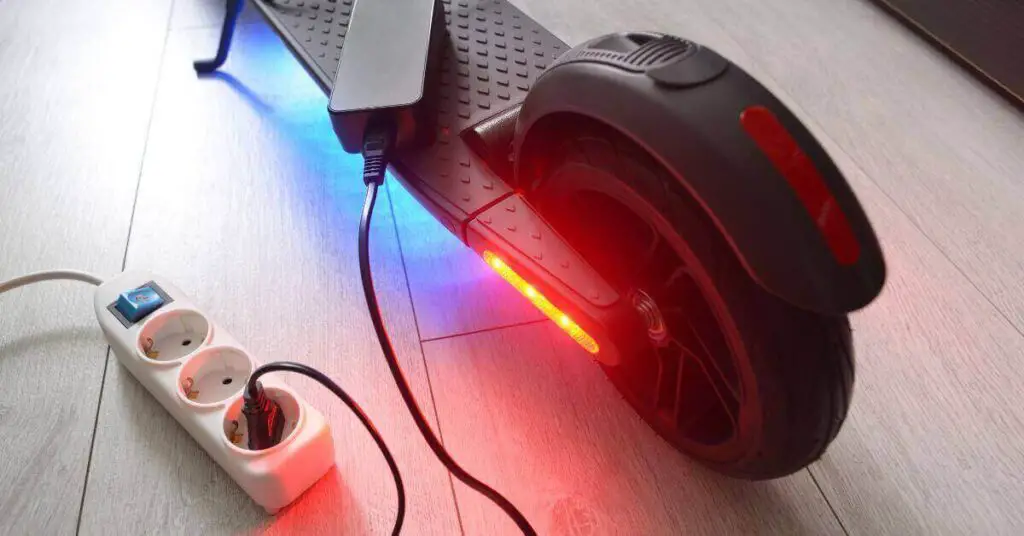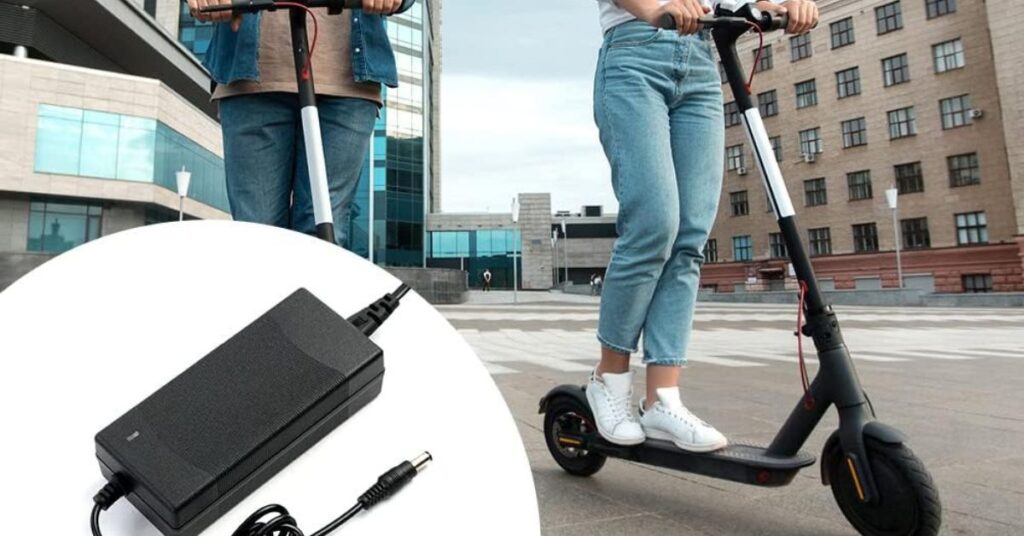
All recommendations within this article are informed by expert editorial opinion. If you click on a link in this story we may earn affiliate revenue.
Embracing the electric scooter trend in the UK?
Excellent choice! Eco-friendly, cost-effective, and thrillingly fun – what’s not to love about these nifty gadgets?
But wait!
There’s an important part of the e-scooter journey that often gets overlooked – the charging process.
Wondering how to charge your electric scooter safely?
You’re in the right place!
This all-inclusive guide, tailored to the UK’s unique electric scooter scene, will turn you into a charging pro in no time.
You’ll extend your battery life, always have a ready-to-roll scooter, and ensure safety isn’t left behind in the dust.
So, are you ready to power up your e-scooter knowledge?
Let’s plug in and get started!

Charging an electric scooter is a straightforward process, but knowing some basics can help you get the most out of your scooter’s battery life.
The first step is to understand your scooter’s battery type.
Most modern electric scooters use lithium-ion batteries due to their lightweight, high performance, and long lifespan.
These batteries typically require specific charging practices to maintain their efficiency and longevity.
A good rule of thumb is to always use the charger that comes with your electric scooter.
These chargers are specifically designed for your scooter’s battery type and voltage, ensuring safe and efficient charging.
Using a different charger can risk damaging your battery or even causing safety issues.
If you need to buy a new charger, make sure it matches the specifications of your original charger.

Before you plug in your electric scooter for charging, there are a few preliminary steps you should take to ensure safety and efficiency.
Firstly, make sure your scooter and the charger are both clean and free from dust or dirt.
A dirty charger can lead to poor connections and longer charging times.
Secondly, check that the charging port on your scooter is not damaged.
Any signs of physical damage or corrosion should be addressed before attempting to charge.
Finally, ensure the area around your scooter is clear and that the scooter is placed on a stable, flat surface.
This is to minimise the risk of it being knocked over during charging, potentially damaging the scooter or causing a safety hazard.
To begin charging, simply connect the charger to your scooter and then plug the charger into an electrical outlet.
A light on the charger will typically indicate that the charging process has started.
It’s important to keep an eye on your scooter during the first few charges, as this is when any potential issues are most likely to occur.
Never leave your scooter charging unattended for long periods or overnight.
While the risk of something going wrong is low, it’s always better to be safe.
Once your scooter’s battery is fully charged (indicated by the light on the charger), it’s best to unplug it as soon as possible.
Leaving your scooter plugged in after it’s fully charged can strain the battery and decrease its overall lifespan.
After charging, allow your scooter to rest for about 15 minutes before you start riding.
This gives the battery time to cool down, which can also help extend its life.
Every now and then, you might face issues with charging your electric scooter.
Perhaps the scooter isn’t charging at all, or it’s charging very slowly.
Maybe the battery isn’t holding a charge for as long as it used to.
First, check your charger and charging port for any visible damage.
Next, try using a different charger if one is available, as this can help determine if the issue is with your scooter or your charger.
If your battery isn’t holding a charge as long as it used to, it may be nearing the end of its lifespan.
Lithium-ion batteries typically last for several hundred charging cycles, but their capacity will slowly decrease over time.
If you’ve tried troubleshooting and your scooter still isn’t charging properly, it’s time to seek professional help.
It’s not advisable to try to repair the battery or charger yourself, as this can be dangerous and may void your warranty.
Reach out to your scooter’s manufacturer or professional repair service for assistance.
To keep your electric scooter’s battery in top shape, regular maintenance is key.
This includes cleaning your scooter and charger, keeping your scooter dry, and storing it in a cool, dry place.
Extreme temperatures, both hot and cold, can negatively impact your battery’s performance and lifespan.
If you won’t be using your scooter for a long period, there are a few steps you can take to ensure the battery remains in good condition.
It’s best to store your scooter with the battery partially charged — around 50-60%.
Storing a lithium-ion battery fully charged or fully discharged can cause it to degrade faster.
Owning an electric scooter comes with its own set of responsibilities, the key among them being understanding how to charge it safely and efficiently.
From the basics of charging, recognising and troubleshooting issues, to the maintenance of your scooter’s battery, we’ve covered all the necessary aspects in this guide.
With these insights, you’re now equipped to ensure your scooter always remains ready to hit the road, while also extending the life of its battery.
1. How long does it take to charge an electric scooter?
The charging time can vary based on the scooter’s model and battery capacity. Typically, it can take anywhere from 4 to 8 hours. Always refer to your scooter’s user manual for specific information.
2. Can I use a different charger to charge my scooter?
It’s best to use the charger provided with your scooter as it is specifically designed for your scooter’s battery. Using a different charger can risk damaging the battery or causing a safety issue.
3. Can I leave my electric scooter charging overnight?
It’s not recommended to leave your scooter charging unattended for long periods, including overnight. Overcharging can strain the battery and reduce its lifespan.
4. How can I maximise my electric scooter’s battery life?
Regular maintenance, safe charging practices, and proper long-term storage can help maximise your scooter’s battery life. It’s also advisable to avoid depleting the battery completely before recharging.
5. What should I do if my scooter isn’t charging properly?
First, check your charger and charging port for any visible damage. If the problem persists, try using a different charger. If none of these steps helps, seek professional assistance.
After diving into the nitty-gritty of charging your electric scooter, we’ve covered quite a journey together.
From understanding the basics to tackling potential issues head-on, you’ve now got all the knowledge you need to keep your scooter running smoothly and safely.
It’s a bit like caring for a pet, isn’t it? Your scooter needs your attention and care, and in return, it will take you places, quite literally!
Never forget that you’re not just looking after your scooter, but also taking care of your own safety, and even making a positive impact on the environment by choosing an electric ride.
Let’s continue learning and growing together in this exciting electric ride experience.
Here’s to all the safe rides and adventures that await us.
After all, every journey starts with that single step – or in our case, a full battery charge!
Stay safe, keep learning, and happy scooting, my friends!